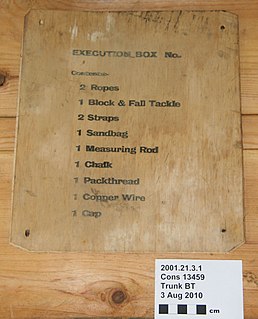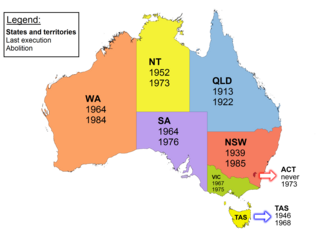Related Research Articles
Capital punishment, also known as the death penalty, is a state-sanctioned practice of killing a person as a punishment for a crime. The sentence ordering that an offender is to be punished in such a manner is known as a death sentence, and the act of carrying out the sentence is known as an execution. A prisoner who has been sentenced to death and awaits execution is condemned and is commonly referred to as being "on death row".
Life imprisonment is any sentence of imprisonment for a crime under which convicted people are to remain in prison for the rest of their natural lives or indefinitely until pardoned, paroled, or otherwise commuted to a fixed term. Crimes for which, in some countries, a person could receive this sentence include murder, torture, terrorism, child abuse resulting in death, rape, espionage, treason, drug trafficking, drug possession, human trafficking, severe fraud and financial crimes, aggravated criminal damage, arson, kidnapping, burglary, and robbery, piracy, aircraft hijacking, and genocide, crimes against humanity, war crimes or any three felonies in case of three-strikes law. Life imprisonment can also be imposed, in certain countries, for traffic offences causing death. Life imprisonment is not used in all countries; Portugal was the first country to abolish life imprisonment, in 1885.
Capital punishment in the United Kingdom was used from ancient times until the second half of the 20th century. The last executions in the United Kingdom were by hanging, and took place in 1964, before capital punishment was suspended for murder in 1965 and finally abolished for murder in 1969. Although unused, the death penalty remained a legally defined punishment for certain offences such as treason until it was completely abolished in 1998; the last execution for treason took place in 1946. In 2004 the 13th Protocol to the European Convention on Human Rights became binding on the United Kingdom, prohibiting the restoration of the death penalty for as long as the UK is a party to the convention.

Capital punishment in New Zealand – the process of sentencing convicted offenders to death for the most serious crimes and carrying out that sentence, as ordered by a legal system – first appeared in a codified form when New Zealand became a British colony in 1840. It was first carried out with a public hanging in Victoria St, Auckland in 1842, while the last execution occurred in 1957 at Mount Eden Prison, also in Auckland. In total, 85 people have been executed in New Zealand.
Capital punishment in Denmark was abolished in 1933, with no death sentences having been carried out since 1892, but restored from 1945 to 1950 in order to execute Nazi collaborators. Capital punishment for most instances of war crimes was legally ended in 1978. The last execution was in June 1950.
Capital punishment in Sweden was last used in 1910, though it remained a legal sentence for at least some crimes until 1973. It is now outlawed by the Swedish Constitution, which states that capital punishment, corporal punishment, and torture are strictly prohibited. At the time of the abolition of the death penalty in Sweden, the legal method of execution was beheading.
Capital punishment in Germany has been abolished for all crimes, and is now explicitly prohibited by constitution. It was abolished in West Germany in 1949, in the Saarland in 1956, and East Germany in 1987. The last person executed in Germany was the East German Werner Teske, who was executed at Leipzig Prison in 1981.
Capital punishment is theoretically a legal penalty but is not allowed in Russia due to a moratorium, and neither executions nor death sentences had been handed or carried out since August 2, 1996. Russia has a moratorium implicitly established by President Boris Yeltsin in 1996, and explicitly established by the Constitutional Court of Russia in 1999 and most recently reaffirmed in 2009. Three foreign fighters were sentenced to death in Russian-backed separatist-occupied Ukraine in June 2022, a region outside of the Russian judicial system.
Capital punishment is a legal penalty in Pakistan. Although there have been numerous amendments to the Constitution, there is yet to be a provision prohibiting the death penalty as a punitive remedy.

Capital punishment in Australia was a form of punishment in Australia that has been abolished in all jurisdictions. Queensland abolished the death penalty in 1922. Tasmania did the same in 1968. The Commonwealth abolished the death penalty in 1973, with application also in the Australian Capital Territory and the Northern Territory. Victoria did so in 1975, South Australia in 1976, and Western Australia in 1984. New South Wales abolished the death penalty for murder in 1955, and for all crimes in 1985. In 2010, the Commonwealth Parliament passed legislation prohibiting the re-establishment of capital punishment by any state or territory. Australian law prohibits the extradition or deportation of a prisoner to another jurisdiction if they could be sentenced to death for any crime.
Capital punishment in Malaysia is a legal penalty, though a moratorium is in force since 2018.
Capital punishment remained in Polish law until September 1, 1998, but from 1989 executions were suspended, the last one taking place one year earlier. There is no death penalty envisaged for in current Polish penal law.
Capital punishment is a long unused form of punishment in Brazil. Its last recorded use was in 1876. Although virtually abolished, it is still possible during wartime, according to the Article 5, XLVII, "a", of the Federal Constitution. Brazil is the most populous country in the world that does not retain the death penalty in practice. It is also one of seven countries to have abolished capital punishment for ordinary crimes only.
Capital punishment in Romania was abolished in 1990, and has been prohibited by the Constitution of Romania since 1991.
Capital punishment was used from the creation of the modern Serbian state in 1804. On 26 February 2002, the Serbian Parliament adopted amendments striking the death penalty from the Criminal Code. The last execution, by shooting, took place on 14 February 1992, and the last death sentences were pronounced in 2001. Serbia is bound by the following international conventions prohibiting capital punishment : The Second Optional Protocol to the International Covenant on Civil and Political Rights, and Protocols No. 6 and No. 13 to the European Convention on Human Rights. According to Article 24 of the Serbian constitution (2006): „Human life is inviolable. There shall be no death penalty in the Republic of Serbia“.
Capital punishment was abolished in Turkey in 2004, and no prisoners have been executed since October 1984. The method of execution was hanging.
In Papua New Guinea (PNG), also officially known as the Independent State of Papua New Guinea, capital punishment was abolished for the second time on 22 January 2022.
Capital punishment was abolished in the U.S. state of North Dakota in 1973. Historically, a total of eight people have been executed in North Dakota, including one execution prior to North Dakota attaining statehood.
Capital punishment is a legal penalty in the U.S. state of Georgia. Georgia reintroduced the death penalty in 1973 after Furman v. Georgia ruled all states' death penalty statutes unconstitutional. The first execution to take place afterwards occurred in 1983.
Capital punishment is a legal penalty in Jordan. The country had a moratorium on capital punishment between 2006 and 2014. In late 2014 the moratorium was lifted and 11 persons were executed. Two more executions followed in 2015, 15 executions took place in 2017 and one in 2021.
References
- 1 2 Zakonik obšči crnogorski i brdski. Zakonik Danila Prvog[The General Code of Montenegro and the Hills. The Code of Danilo the First], facsimile edition, 1982, p. xxviii
- 1 2 Karadžić, Vuk (1969). Sabrana dela [Collected Works], XVIII. Belgrade. p. 656.
- ↑ Popović, Petar (1951). Crna Gora u doba Petra I i Petra II [Montenegro in the times of Petar I and Peter II], Belgrade. p. 297.
- ↑ Bojović, Jovan (1982). Zakonik knjaza Danila [Prince Danilo's Code], Titograd, p.49.
- ↑ Krivični zakonik za Knjaževinu Crnu Goru [Penal Code for the Princedom of Montenegro], Cetinje 1906.
- 1 2 Janković, Ivan (2012). Na belom hlebu: Smrtna kazna u Srbiji, 1804–2002 [On white bread diet: The death penalty in Serbia 1804-2002]. Belgrade. Ch.8-10
- ↑ Statistički godišnjaci Kraljevine SHS / Jugoslavije [Statistical Yearbooks of the Kingdom SHS / Yugoslavia]. Belgrade. 1921-1941.
- ↑ "skazna > Osudjenik". www.smrtnakazna.rs. Retrieved 2020-08-11.